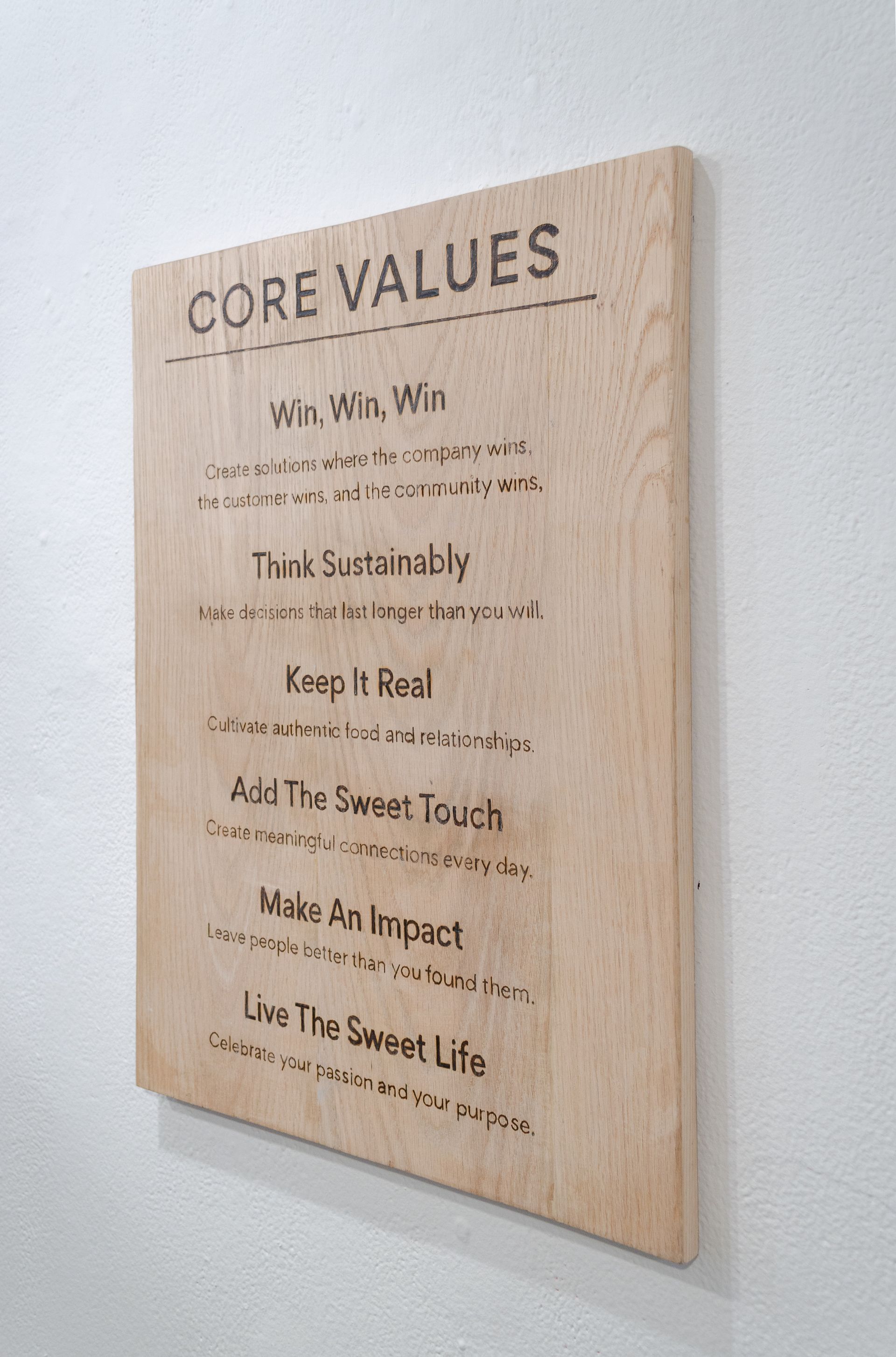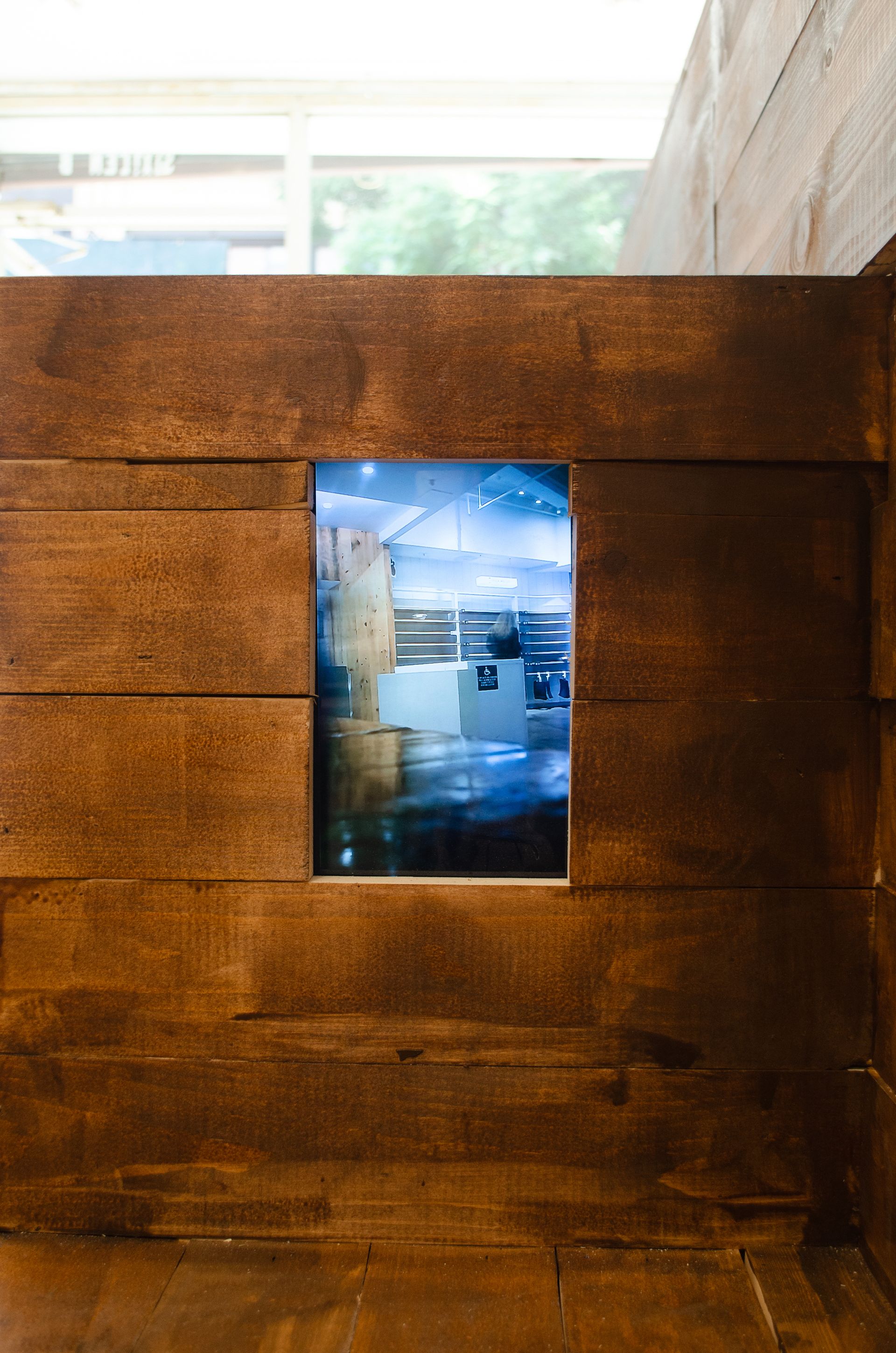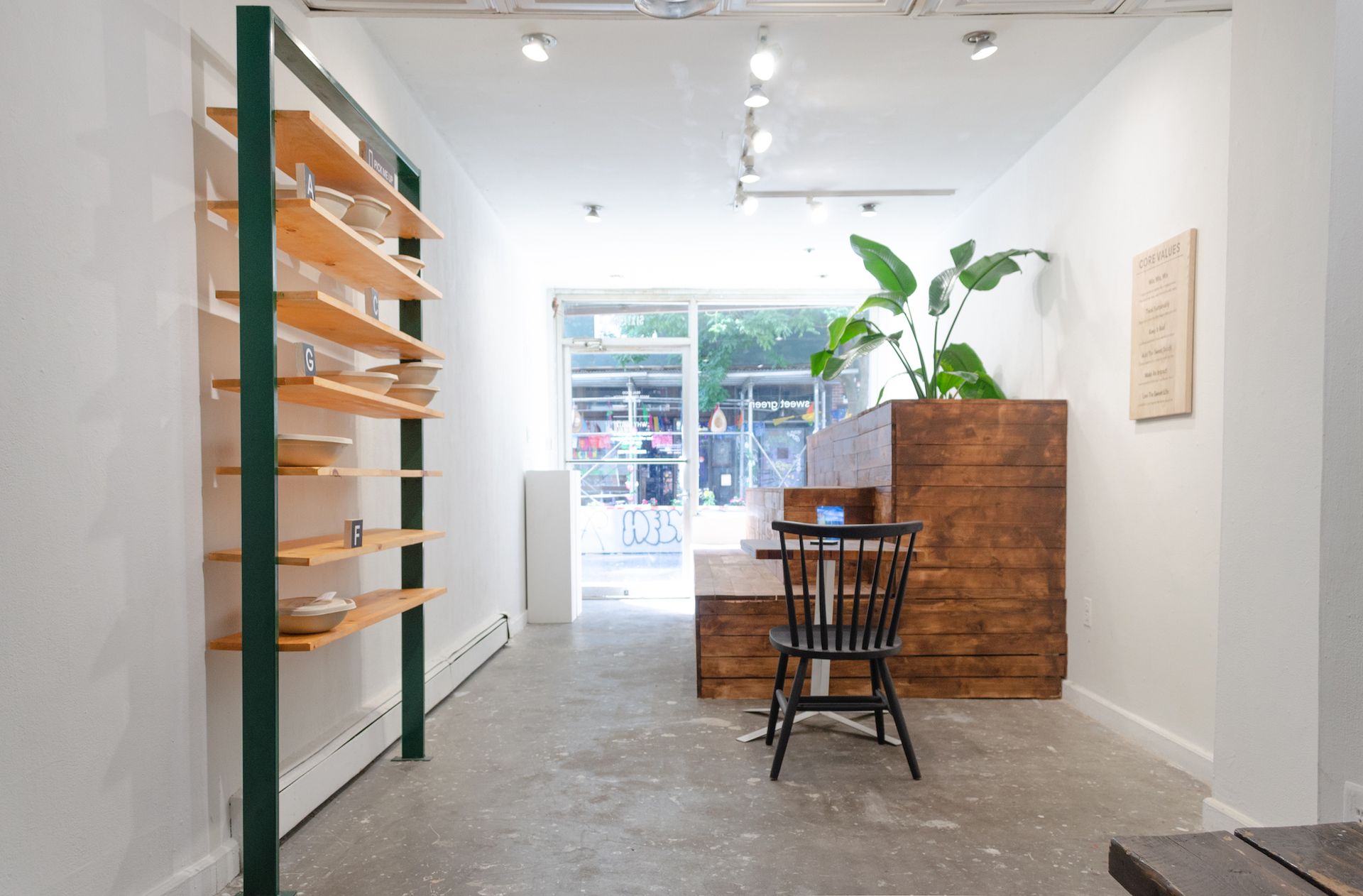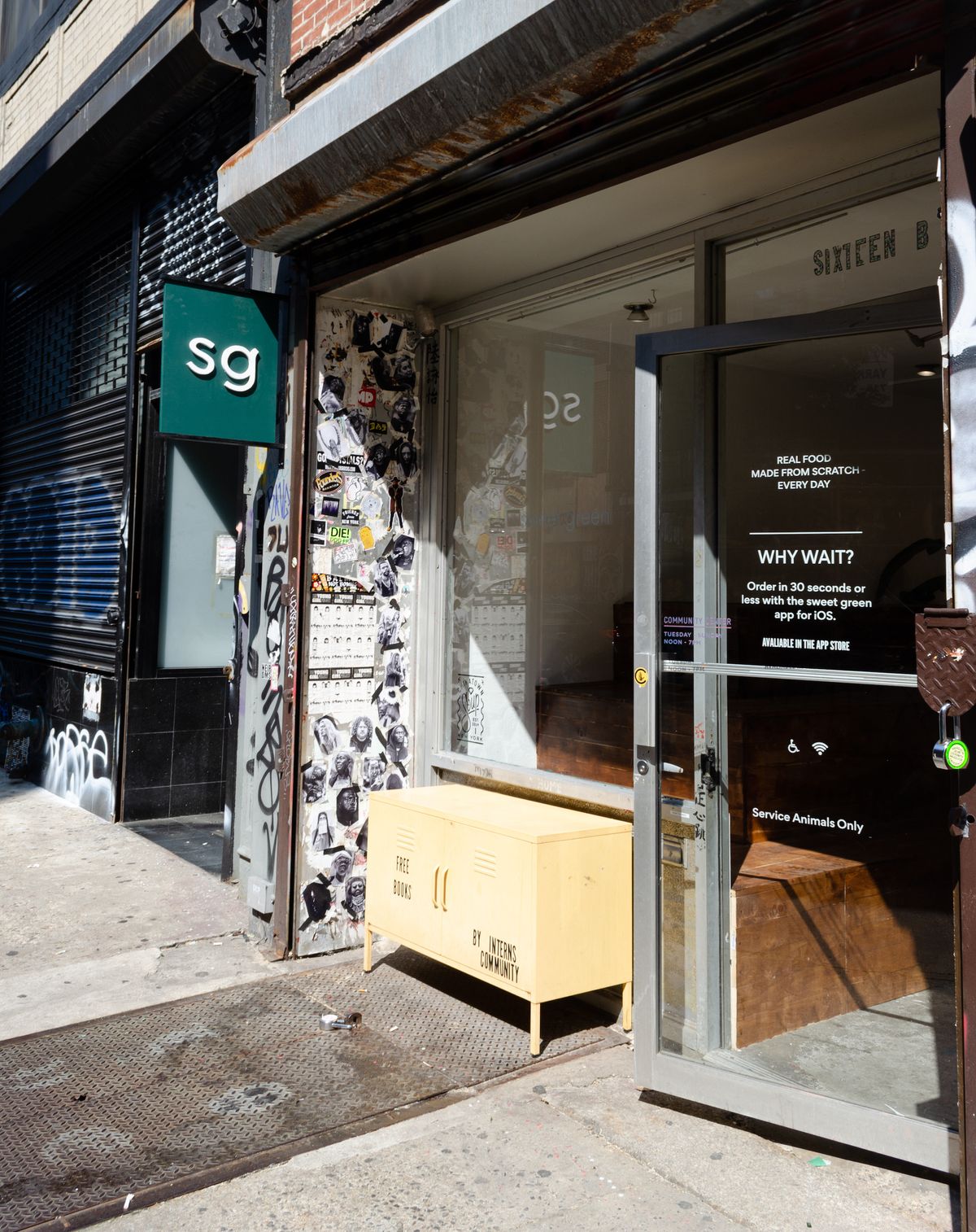The kale-hued sign outside the storefront in Manhattan’s Chinatown read “sg”—instantly recognizable shorthand for Sweetgreen, the eco-chic chain known for its salads and grain bowls. But during its operating hours over two weeks in July, anyone who attempted to purchase food there left empty-handed.
The small space at 16B Orchard Street is home to the gallery Chinatown Soup, which the artist Alexander Si transformed into a simulation of a Sweetgreen outpost from 12 to 24 July. Replicas of communal benches and a shelf displaying compostable bowls were visible behind the glass facade, which featured convincing decals with the chain’s motto and instructions to place orders online. A sign on one wall announced the business’s core values, ranging from “Win, Win Win” to “Live the Sweet Life”.

Installation view of sweet green (2022) by Alexander Si at Chinatown Soup Courtesy the artist
Si, who installed sweet green (2022) as part of his residency at Chinatown Soup, says one of his goals was to scrutinise the racial hierarchies evident in the literal white space of Sweetgreen, where people of colour, largely, serve mostly white customers at a breakneck pace. “I still don’t mind going there myself, but the more I go, the weirder it becomes because I’m looking at the juxtaposition between the staff and the clientele, and there’s an avoidance of eye contact between them,” Si says. “That feeling of uncomfortable awkwardness is where I began researching the company and looking more into how everything is so designed.”
Born in China, Si studied in Toronto before moving to New York in 2019; he lives on East Broadway, a stone’s throw from Chinatown Soup. His interest in peeling back Sweetgreen’s look to critique ubiquitous power dynamics stems, in part, from this migration story. “I always had this kind of American dream, and there’s that tier of businesses—Sweetgreen, Juice Press, SoulCycle, Warby Parker—that cluster of brands, to me in the early 2010s, signalled a type of Americanness, of being able to blend in,” he says. “I’ll go in, and I feel kind of high class, and a little white, too.”
This draw, he adds, speaks to the advertising success of these cult-status brands, whose minimalist aesthetics gesture to a particular type of luxury. “The reason I chose Sweetgreen is I feel like they’re at an epitome in terms of their marketing and brand identity.”
Handcrafting every object in the gallery was his way of trying to understand this phenomenon, Si says, likening the process to his method of learning English by copying phrases over and over. “Repetition to me is a way of trying to learn a different culture.” The installation was also his attempt at “reclaiming” this corporate environment. “It’s not a space designed for people of colour, and I’m trying to insert myself into the space by embedding my labour into it. I can feel the staff’s labour that is mostly invisible, and who actually built these structures.”
These dynamics were made plain in a durational performance held at the exhibition opening, in which performers reenacted “The Sweet Talk”, a team huddle that occurs every morning at real Sweetgreen locations. Si and six others, wearing Sweetgreen uniforms, launched into a call-and response: a “manager” shouted “Sweet!” and the rest yelled “Green!” for 20 minutes, their mounting exhaustion exaggerating the monotonous team-building exercise and effectively dramatising burnout.
As part of his research, Si interviewed Sweetgreen employees and spent hours loitering in various Sweetgreen locations. He also lodged screens playing video documentation of the chain’s interiors into his benches. While he has not received any communications from the company, its co-founder Nicolas Jammet began following him on Instagram. “I don’t know how to compute that,” Si says.

Installation view of sweet green (2022) by Alexander Si at Chinatown Soup Courtesy the artist
The project has also drawn a mix of responses from the public. Some visitors who entered while the show was being installed were excited by Sweetgreen’s arrival to the neighbourhood; a handful even asked about job opportunities. One person said they were going to start a community text thread to protest the new business. And every day, close to two dozen people entered asking for salads.
Meanwhile, Si noticed that little inquiry came from the handful of Chinese neighbours who popped in. “All I wanted to do is bring up the conversation with residents, everyone that passed by, about gentrification, who is the gentrifier and who has been gentrified,” Si says. “It made total sense when I was planning the show to make it [in Chinatown]...I’ve seen how the neighbourhood—Dimes Square, Orchard, Canal—how it became the most hip, ‘undiscovered’, alternative spot.”
Jan Lee, a third-generation Chinatown resident, told Gothamist that the installation dwelled too much on gentrification by “white American businesses”, explaining that the proliferation of liquor licences presents a greater threat to the area. But Si says he wanted to focus on this type of business because “it represents something that’s even fearful for these mostly white people that moved into the neighbourhood. It’s making it less hip, and that’s casting such a terror.

Installation view of sweet green (2022) by Alexander Si at Chinatown Soup Courtesy the artist
“It is a commentary on whiteness,” Si adds. “I want to make it as white as possible because it’s symbolising what these newcomers are basically doing, but they’re just not doing it in this kind of corporate identity, white-white-white way, like Sweetgreen. They’re doing it in a more shabby, vintage-looking French restaurant way.”
Sweet Green reflects Si’s broader interest in examining surreal moments in mainstream American culture and reframing them through replication. His previous projects include Britney (b. 1981) (2021), composed of a receipt printer that generated documents exemplifying the mass of publicly available information on Britney Spears, and Self Help (2021), which filled a Little Free Library with feminist self-help books to embody the “gaslight, gatekeep, girlboss” meme. His next project, set to open at Spaces gallery in Cleveland in March 2023, will draw on his research into Amazon fulfilment centres.
“That’s the throughline in my practice—finding these moments that I personally find weird as an Asian American immigrant in this country but looking at it more critically,” Si says. “These [works] are almost investigative journalism, trying to understand or trying to make America think differently. All of these are things I think most Americans take for granted—they don’t think twice about…but there’s deeper issues there.”


